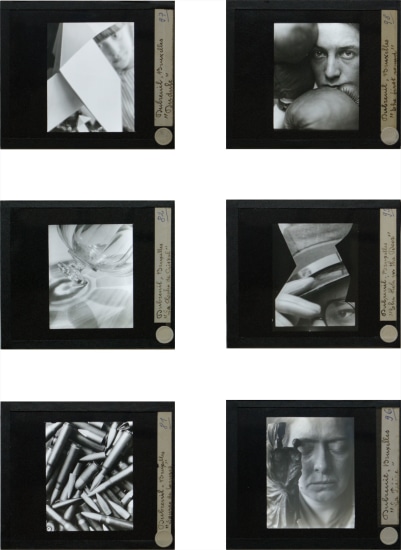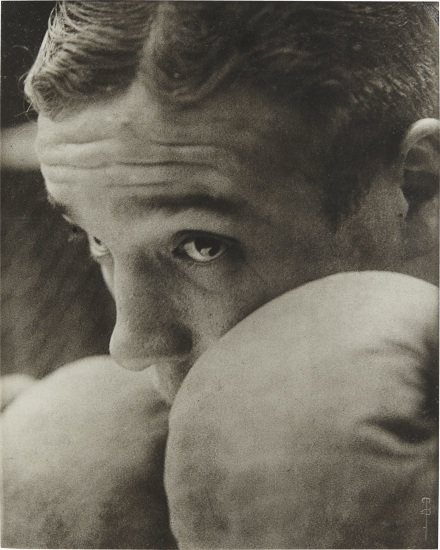Pierre Dubreuil T.S.F. 1928 Oil print. 9 3/4 x 7 5/8 in. (24.8 x 19.4 cm) The artist's monogram and date on the recto; titled in pencil on the mount; signed twice, titled in pencil and 'DB/69' stamp on the reverse of the mount.
Provenance The collection of Tom Jacobson, San Diego Exhibited Pierre Dubreuil Retrospective, The Royal Photographic Society, London, 1935 Pierre Dubreuil Rediscovered, The Museum of Photographic Arts, San Diego, 1988; Alliance Francaise, New York, 1989; The Detroit Institute of the Arts, 1990 Catalogue Essay Pierre Dubreuil was a master constructor of images. He did not “take” photographs he “made” them. The man behind the mask in his masterpiece The Play of Life (Self-portrait), circa 1930 (lot 173) is the photographer himself. He is the wizard behind the scenes pulling the strings. French born, Dubreuil was an extremely astute photographer who created beautiful and complex images. He started as a Pictorialist in the first decade of the Twentieth Century, but by the time he made this self-portrait, the present lot, and the other three photographs being offered as lots 174-176 , Dubreuil was creating outstanding images of modern life that are multilayered in both their dynamic construct and in their meaning. T.S.F., circa 1928 is a constructed Modernist image that depicts life in relationship to new technology with an unusual perspective and layered meanings. Using a large format camera mounted on a tripod, Dubreuil cleverly angled his lens (and our focus) through the foreground of an opened case of a wireless radio (Transmission Sans Fils) - literally framing the image of a contemporary woman by the technology she is using. Peaking out from under the wildly popular new technology for transmitting communication is the (not so obvious) cover of Camera Work, Alfred Stieglitz’ quarterly magazine that carried overseas to amateur photographers such as Dubreuil the latest ideas in photography and modern art. At the time Dubreuil created The Play of Life (Self-portrait) (lot 173) and T.S.F. he was a Modernist living in Brussels, Belgium. His career began, as did Alfred Stieglitz’ who was eight years his senior, as a Pictorialist. But while other pictorial photographers favored domestic and rural scenes, both Stieglitz’ urban shots of New York City taken at the turn of the century and Dubreuil’s radically layered and juxtaposed images of Paris from 1908-1910 distinguished them as proto-modernists. In 1903 Dubreuil was elected into The Linked Ring, the highly regarded English photographic society that included the most respected photographers of that time including Alfred Stieglitz Edward Steichen Frederick H. Evans and Gertrude Käsebier The goal of the Pictorialist movement was to ensure that photography be appreciated as an art form. They did this through the beauty of their prints and as seen in the present lot as well as lots 173-174, Dubreuil made stunningly beautiful prints. All three are oil prints, a process that was introduced in 1904 by G.E.H. Rawlins. Robert Demachy described the Rawlins oil process in Camera Work (which Dubreuil was an avid reader of) in 1906. The process uses dichromated gelatin -which when exposed to light will harden and subsequently accept oil-base ink. Dubreuil contact printed his 8 x 10 glass negatives on paper, and then applied ink with a brush to the developing photograph’s hardened and sticky surface. By hand-applying the oil-based ink, and using several applications of ink on the same print, he could darken or lighten the final print as he wished. Dubreuil was possibly the greatest master of the permanent process of oil printing with these three prints being superb examples. That Dubreuil continued to use the oil print process in the 1920s and early 1930s got him relegated to showing with the late Pictorialists in America, but by European standards his later photographs were considered radical and Modern. In America, Modernism in photography became defined by the rejection of the printing processes used by the Pictorialists. Alfred Stieglitz’ transformation to a Modernism is seen historically to have occurred at the time of his introduction of Paul Strand and the “straight” photographic print.
Pierre Dubreuil T.S.F. 1928 Oil print. 9 3/4 x 7 5/8 in. (24.8 x 19.4 cm) The artist's monogram and date on the recto; titled in pencil on the mount; signed twice, titled in pencil and 'DB/69' stamp on the reverse of the mount.
Provenance The collection of Tom Jacobson, San Diego Exhibited Pierre Dubreuil Retrospective, The Royal Photographic Society, London, 1935 Pierre Dubreuil Rediscovered, The Museum of Photographic Arts, San Diego, 1988; Alliance Francaise, New York, 1989; The Detroit Institute of the Arts, 1990 Catalogue Essay Pierre Dubreuil was a master constructor of images. He did not “take” photographs he “made” them. The man behind the mask in his masterpiece The Play of Life (Self-portrait), circa 1930 (lot 173) is the photographer himself. He is the wizard behind the scenes pulling the strings. French born, Dubreuil was an extremely astute photographer who created beautiful and complex images. He started as a Pictorialist in the first decade of the Twentieth Century, but by the time he made this self-portrait, the present lot, and the other three photographs being offered as lots 174-176 , Dubreuil was creating outstanding images of modern life that are multilayered in both their dynamic construct and in their meaning. T.S.F., circa 1928 is a constructed Modernist image that depicts life in relationship to new technology with an unusual perspective and layered meanings. Using a large format camera mounted on a tripod, Dubreuil cleverly angled his lens (and our focus) through the foreground of an opened case of a wireless radio (Transmission Sans Fils) - literally framing the image of a contemporary woman by the technology she is using. Peaking out from under the wildly popular new technology for transmitting communication is the (not so obvious) cover of Camera Work, Alfred Stieglitz’ quarterly magazine that carried overseas to amateur photographers such as Dubreuil the latest ideas in photography and modern art. At the time Dubreuil created The Play of Life (Self-portrait) (lot 173) and T.S.F. he was a Modernist living in Brussels, Belgium. His career began, as did Alfred Stieglitz’ who was eight years his senior, as a Pictorialist. But while other pictorial photographers favored domestic and rural scenes, both Stieglitz’ urban shots of New York City taken at the turn of the century and Dubreuil’s radically layered and juxtaposed images of Paris from 1908-1910 distinguished them as proto-modernists. In 1903 Dubreuil was elected into The Linked Ring, the highly regarded English photographic society that included the most respected photographers of that time including Alfred Stieglitz Edward Steichen Frederick H. Evans and Gertrude Käsebier The goal of the Pictorialist movement was to ensure that photography be appreciated as an art form. They did this through the beauty of their prints and as seen in the present lot as well as lots 173-174, Dubreuil made stunningly beautiful prints. All three are oil prints, a process that was introduced in 1904 by G.E.H. Rawlins. Robert Demachy described the Rawlins oil process in Camera Work (which Dubreuil was an avid reader of) in 1906. The process uses dichromated gelatin -which when exposed to light will harden and subsequently accept oil-base ink. Dubreuil contact printed his 8 x 10 glass negatives on paper, and then applied ink with a brush to the developing photograph’s hardened and sticky surface. By hand-applying the oil-based ink, and using several applications of ink on the same print, he could darken or lighten the final print as he wished. Dubreuil was possibly the greatest master of the permanent process of oil printing with these three prints being superb examples. That Dubreuil continued to use the oil print process in the 1920s and early 1930s got him relegated to showing with the late Pictorialists in America, but by European standards his later photographs were considered radical and Modern. In America, Modernism in photography became defined by the rejection of the printing processes used by the Pictorialists. Alfred Stieglitz’ transformation to a Modernism is seen historically to have occurred at the time of his introduction of Paul Strand and the “straight” photographic print.














Try LotSearch and its premium features for 7 days - without any costs!
Be notified automatically about new items in upcoming auctions.
Create an alert